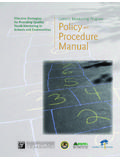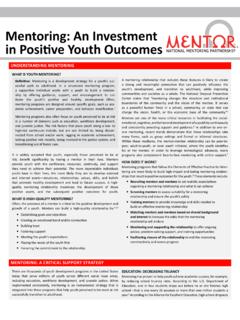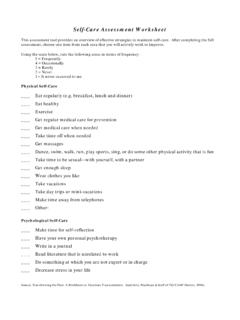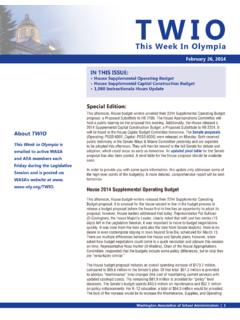Transcription of The Legislative Process: How a Bill Becomes a Law and ...
1 MENTOR: The National Mentoring Partnership The Legislative process : How a bill Becomes a Law and Legislative Terms Every piece of legislation must go through a series of steps in order to become law. At each step of the way, a bill can be defeated or simply not brought up for consideration, effectively preventing the bill from becoming law. This is why support for a bill must be solicited at so many times throughout the Legislative process . 1. The bill is introduced. Depending on the subject matter of the legislation, it may be called a bill or a resolution. Any Member of Congress can introduce a piece of legislation, which is then given a number ( # for House bills, and S. # for senate bills). The Member introducing the bill is known as the "sponsor". Other Members who support the bill can be listed as "co-sponsors" of the legislation. 2. The bill is referred to a Committee.
2 Both the House and senate have Committees that are assigned specific jurisdictions. For example, the senate Finance Committee handles tax bills. A newly introduced bill is referred to the Committee(s) with expertise in its issue for further consideration. The Committee may then assign the bill to one of its Subcommittees. If a Committee does nothing further with the bill , it will "die" ( not become law) in Committee. 3. The Committee holds hearings on the bill . Either the Subcommittee or full Committee, or both, may hold hearings on the piece of legislation. Witnesses testify about possible ramifications, positive or negative, of the legislation. Members of Congress may ask questions of the witnesses, and make statements about their views on the legislation. Many pieces of legislation skip this step. 4. The Committee "marks-up" the bill . Again, this can take place first at the Subcommittee level and then at the full Committee level, or be considered only by the full Committee.
3 A "mark-up" session is when the Committee decides whether or not to accept or reject a piece of legislation. Amendments can be offered to alter the original piece of legislation, and are discussed and then voted on by the Committee Members. Once all amendments and debate are complete, a vote is taken on final passage for the legislation. If it passes, it is "reported out" of Committee, meaning that Committee Members write a report explaining the legislation's purpose and their views, and recommend it for consideration by the full House of Representatives. If the bill is defeated, it will be "tabled," meaning that the bill will not receive any further Legislative consideration, and is effectively dead. 5. The bill is considered on the "floor". Floor consideration simply means that the full House or full senate is considering the bill . During floor consideration, Members debate the pros and cons of the bill .
4 Amendments can be offered, debated, and voted on. In the House, a rule, set by the Rules Committee, may govern the length of debate and number and type of amendments that can be offered during debate. In the senate , the Majority Leader sets the structure of the debate. At the end of all debate and amendments, the full House or senate votes on final passage of the bill . Whichever chamber passes the bill first then sends it to the other chamber, unless a similar bill is already under consideration there. 6. The bill goes to Conference Committee. If the House and senate pass different versions of a bill , a Conference Committee will be appointed to negotiate a compromise. This Conference MENTOR: The National Mentoring Partnership Committee is generally made up of senior members from the Committee that initially considered the bill . Conferees must settle every difference between the two bills.
5 Once agreement has been reached, the Conferees write a conference report that is then submitted to both the House and senate . (Note: If the House and senate bills are identical, the bill skips both steps 6 and 7 and is sent directly to the President). 7. The Conference Report is considered. Both the House and senate must approve the Conference report in identical form. There is generally debate about the report before a vote on final passage is called. 8. The bill is sent to the President. After the Conference report is approved by both the House and senate , the bill is sent to the President for review. He can sign the bill into law or veto it. If vetoed, Congress can attempt to override the President's veto. This takes a two-thirds vote in both the House and the senate . 9. The bill Becomes a law. After the President signs a bill or Congress overrides a veto, the bill officially Becomes a law.
6 It will be assigned an official law number (such as 107-15), and will be listed as part of the United States Code. Definition of Legislative Terms: Appropriation: This is the process by which Congress allocates public funding for all government spending each year. Without an annual appropriation, a federal agency or program cannot operate. The appropriations process has several steps. First, the President submits a budget requesting specific funding levels for all federal agencies and programs. The Appropriations Committee, broken down into subcommittees, considers the various categories of spending. The Budget Committee gives the Appropriations Committee an overall spending figure, which is then divided by the Chairman between the various Subcommittees. The Subcommittees then determine specific funding levels for all the agencies and programs within their jurisdiction.
7 The resulting appropriations bill then follows the normal Legislative procedure outlined above. Authorization: This is the process by which Congress creates an agency or program and broadly defines the purposes of that agency or program. bill : This is a document outlining a Legislative proposal to either change existing law by adding, modifying, or deleting current laws or to appropriate funding. Cloture: This is a motion used during senate floor consideration to limit debate on a bill . It takes 60 votes to invoke cloture. This can be used to end a filibuster. Committee: This is a group made up of Members that is assigned a set of responsibilities. For example, the House Ways and Means Committee has jurisdiction over all tax legislation. Conferees/Conference Committee: A group of Members from each chamber assigned to negotiate a compromise between differing versions of a bill passed by the House and senate .
8 MENTOR: The National Mentoring Partnership Filibuster: This is a means by which a Senator may attempt to defeat a bill by talking indefinitely, preventing the senate from voting on the bill or considering any other business. A filibuster can be ended by invoking cloture. Floor: This refers to the full House or full senate . If a bill is being considered on the "floor", it is being debated and voted on by the full House or full senate . Germane: This means pertinent to the subject matter. As a rule (which is sometimes violated), all amendments offered during consideration of a bill must be germane to the original bill . Hearing - A meeting at which a House or senate Committee hears testimony about a specific bill or a Legislative issue. Mark-up: This occurs when a Committee or Subcommittee considers a specific piece of legislation. The mark-up session can include debate, offering of amendments, and a vote on final passage of the legislation.
9 Referral: Each bill is assigned to a specific Committee for further consideration. This process is called a referral. Report out: This is when a Committee passes a bill during a mark-up session. The Committee will then write a report explaining the bill 's merits in preparation for consideration on the floor of the House or senate . Resolution: This is a form of legislation, alternate to a bill . It is used for Legislative proposals that do not have the effect of law - namely for commendations, expressions of opinions, requests for action of other entities, or for internal organization (such as the establishment of a Committee). Riders: These are amendments added onto a bill that do not pertain to the bill 's subject matter. A rider violates the "germaneness" rule, and usually would not pass if offered as a stand-alone bill . Sponsor (or Co-Sponsor): The sponsor is the Member who originally introduced a bill .
10 Co-sponsors are other Members who sign on to a bill to demonstrate their support. Table: This occurs when a Committee or the full House or senate vote to delay further Legislative action on a bill . This effectively means the bill is dead, and will not become law. Veto: When the President rejects a bill presented to him. Unless the veto can be overridden, the bill will not become law.













